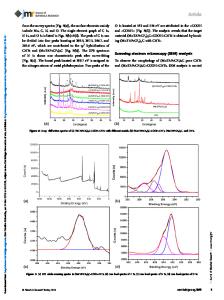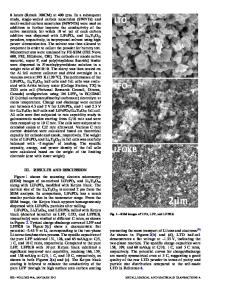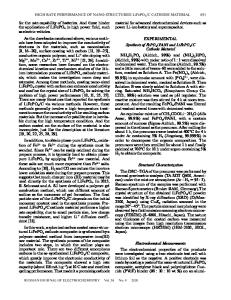Structure and electrochemical performance of LiFePO 4 modified with mononuclear and binuclear phthalocyanines as cathode
- PDF / 697,737 Bytes
- 9 Pages / 584.957 x 782.986 pts Page_size
- 46 Downloads / 531 Views
series of lithium iron phosphate (LiFePO4) nanocomposites are prepared by a solvothermal method coupled with high temperature calcination using mononuclear and binuclear metal hexaaminophthalocyanines as modulatory additives, respectively. Physical and electrochemical performances of the composites as cathode materials of lithium-ion batteries are characterized by inductively coupled plasma (ICP), X-ray diffraction (XRD), infrared (IR), scanning electron microscopy (SEM), transmission electron microscopy (TEM), and electrochemical techniques. The results indicate that the as-synthesized samples modified with binuclear metal phthalocyanines can improve electrochemical properties of LiFePO4 (LFP) for lithium-ion batteries. The composite using binuclear manganese hexaaminophthalocyanine as additive can achieve the highest initial specific discharge capacity of 152.3 mAh/g at 0.1 C, higher than that of ones modified with the corresponding mononuclear phthalocyanine 143.0 mAh/g. Furthermore, the most excellent product exhibits a pretty good capacity retention of 93.0% after 50 cycles at 0.1 C, cycling stability, and low charge transfer resistance of 58.7 X.
I. INTRODUCTION
Lithium-ion batteries (LIBs) have taken dominating position in powering and portable electronic devices in recent years, which is due to their obvious advantages such as high power and energy density, rechargeable ability, long cycling life, great stability, and safety.1,2 Compared with a variety of cathode materials including layered LiCoO2 and spinel LiMn2O4, ordered olivinestructured LiFePO4 has attracted extensive attention owing to its high theoretical capacity of 170 mAh/g, acceptable voltage platform of 3.4 V (versus Li1/Li), nontoxicity, low cost, good safety, thermal stability, as well as environmental benignity.3,4 The phosphorous atoms occupy tetrahedral sites, while the iron and lithium atoms occupy octahedral sites. The FeO6 octahedra are linked through common corners in the bc-plane, and the LiO6 octahedra form edge-sharing chains along the b-axis. One FeO6 octahedron has common edges with two LiO6 octahedra and a PO4 tetrahedron. PO4 groups share one edge with an FeO6 octahedron and two edges with LiO6 octahedra.5 However, the intrinsic drawbacks, low electronic conductivity and sluggish lithium-ion diffusion,
Contributing Editor: Chongmin Wang Address all correspondence to these authors. a) e-mail: [email protected] b) e-mail: [email protected] DOI: 10.1557/jmr.2017.16
create obstacles in the widespread application of the material in LIBs.6 Fortunately, the barrier can be hurdled through diversified modifications of LiFePO 4 . Among numerous endeavors, methods containing carbon coating, foreign elements doping, morphological controlling, and synthesis of nanoparticles can improve the electrochemical performance of the composites efficiently.7–11 Nevertheless, a single approach is not enough, excessive carbon coated on the surface of particles would decline the overall energy density of the material, and superabundant metal doped in the co
Data Loading...











